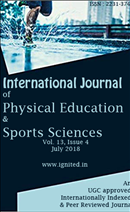Prevalence of Lordosis in Madhya Pradesh: A Study Seeking the Interaction Effect of Region and Gender on Degree of Lordosis in Madhya Pradesh Examining the Impact of Region and Gender on the Prevalence of Lordosis in School Children of Madhya Pradesh
Main Article Content
Authors
Abstract
The primary purpose of the study was to find out the interaction effect of region and gender the degree of lordosis among the school children of Madhya Pradesh. The secondary purpose of the study was to find out that whether the degree of lordosis is equal in all the selected regions of Madhya Pradesh irrespective of the different gender. A total of 500 school children in the age range of 10-15 were selected from the four districts (Bhind, Bhopal, Morar and Shivpuri) of Madhya Pradesh was selected as the sample for the study. Lordosis was measured by measuring the angles of thoracic curve with the help of a flexicurve ruler. Anyone who was having 45 or more than 45 degree was kept into the category of lordotic. The data was analyzed by employing descriptive statistics and 2×4 way factorial Anova. The level of significance was set at .05.Results of the study revealed that 43 percent of school children in different regions of Madhya Pradesh were suffering from lordosis. It was found that Shivpuri region has the highest percentage of lordosis followed by Morar, Bhopal and Bhind. The two way factorial analysis revealed insignificant mean difference of degree of lordosis among the male and female children. Results also revealed a significant mean difference of degree of lordosis among the different regions as well as when the region combines with the gender (interaction). Thus it can conclude that there is a significant effect of interaction on the school children of Madhya Pradesh.The results showed that mean difference of degree of lordosis among the male school children of Bhind and Morar is significantly higher than the female children. Contrary to this the Bhopal and Shivpuri has the significantly higher mean degree of lordosis among females than male children. Thus it can be concluded that mean degree of lordosis is not equally distributed over to different genders in all the selected regions of Madhya Pradesh.
Downloads
Download data is not yet available.
Article Details
Section
Articles

